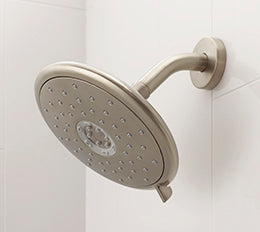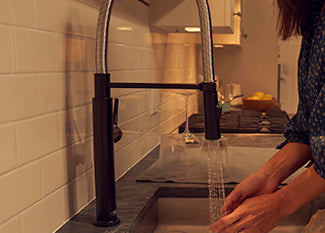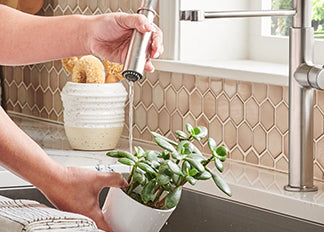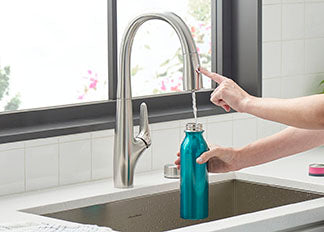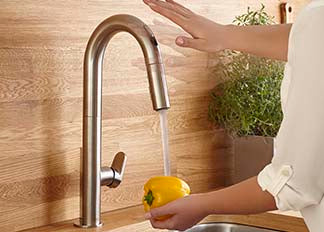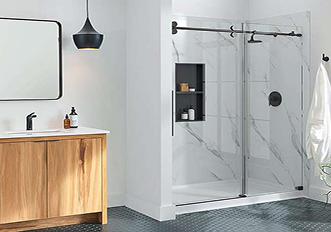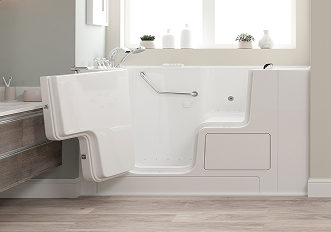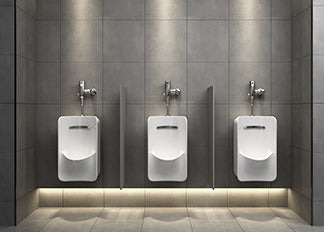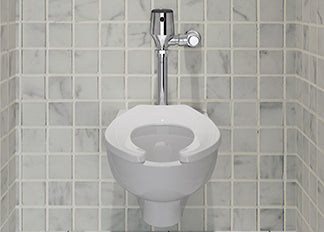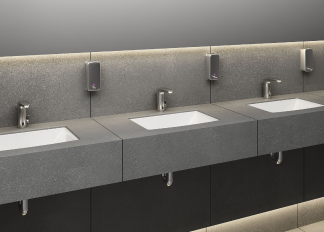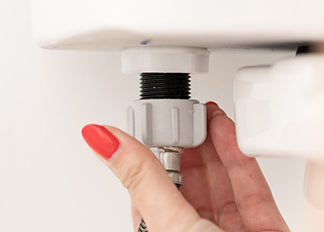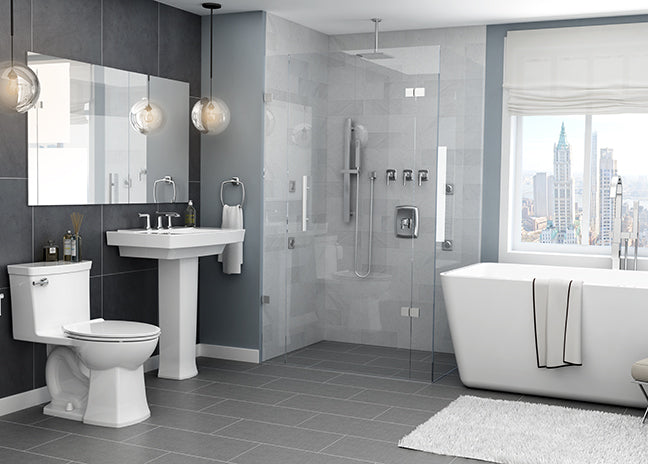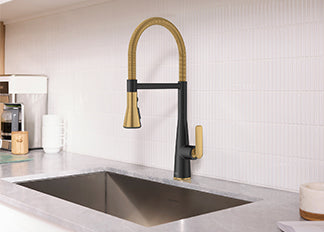Lead-Free in 2009*
All Bathroom & Kitchen Faucets
Why Lead Free?
Safer Drinking Water from Every Faucet
American Standard is lead-free* in 2009!
Historically, our faucets have used less lead than many of our competitors, thanks to our investment in a low-lead manufacturing technology more than 25 years ago.
Now American Standard's new alloy formulation reduces the amount of lead even further by replacing lead with bismuth. This means you still get the same high-quality faucets and mere trace amounts of lead. In fact, our new faucets have less than one quarter of one percent (0.25%) total lead content by weighted average!
After all, why should you have to compromise style and quality for safety?
How Does It Work?
Low-Lead and Lead-Free Technology
American Standard's faucets have long used less lead than many of our competitors because of our commitment to brass casting technology - a more expensive but superior technology.
We use permanent metal casting molds to create our faucets rather than the less expensive sand castings. These higher-performance metal molds can be preheated so that when the brass alloy is poured, the metal remains in a liquid state longer. This permits us to use lower levels of lead in the alloy mix because the alloy remains fluid longer to completely fill the casting's form before hardening.
Now we have altered our alloy mix to bring you the same great quality faucet, but our new brass alloy formulation reduces the small amounts of lead even further by replacing lead with bismuth - an element with similar properties to lead, but with proven safe use in cosmetics and pharmaceuticals.
While other manufacturers are substituting plastic for metal, we chose to modify our brass alloy in order to maintain our high quality standards and reduce the lead content. We're proud to be able to offer this innovative technology in stores nationwide.
• See All Bathroom Faucets
• See All Kitchen Faucets
• Press Release About Lead-Free
Where Can I Learn More?
Learn More About Lead-Free
SafePlumbing.org
safeplumbing.org
Centers for Disease Control Lead Poisoning Prevention Program
cdc.gov
Centers for Disease Control Tips to Prevent Lead Exposure
cdc.gov
Environmental Protection Agency
epa.gov
National Lead Information Center
NSF list of certified manufacturers
_____________________________________________________________________________________________________________________________________________________________
Safe Drinking Water Legislation
American Standard's new technology reflects recent legislation in California and Vermont that will take effect on January 1, 2010. Unlike existing safeguards, such as the Federal Safe Drinking Water Act (SDWA) that limits the amount of minerals that can be leached into the drinking water, California's AB1953 and Vermont's S152 focus on the amount of lead used in the manufacture of faucets.
"In 1974, the federal Safe Drinking Water Act (SDWA) addressed the true public health concern – how much lead is ingested in our nation's drinking water," explained Dave Meisner, vice president and general manager at American Standard. "Now with our faucet's total lead content comprising 0.25%, our public safety dialogue should shift to our aging infrastructure, which is the main source of trace amounts of lead in the water supply."
FAQ's
Frequently Asked Questions about Lead-Free Technology
Why is lead used in plumbing systems?
Lead is a soft element that effectively prevents pinhole leaks in pipes and faucets. It also acts as a lubricant during machining operations to produce clean, precise threads and smooth, flat surfaces that can create reliable, pressure-tight connections to water lines.
For those reasons, 100 percent lead pipes were the most advanced technology to bring water from the utilities to homes and businesses. Some major U.S. cities still have those lead pipes as part of their infrastructure.
Most bathroom faucets sold in the United States and around the world are made from brass, a mix of copper, zinc and a minute amount of lead. It is important to note that the metal composition of faucets is far less important to consumers than the actual amount of lead they might leach into the water. The bottom line for public safety is how much lead can potentially be ingested.
In 2006, the American Waterworks Association Research Foundation (AWWARF) concluded that faucet lead levels in the United States leach less than 2 parts per billion, or roughly 1/4 teaspoon of water in an Olympic-sized pool. These levels are far below the allowable 11 parts per billion mandated by the U.S. Government’s 1996 Safe Drinking Water Act.
Are faucets the main contributors of lead in drinking water?
No. As noted above, aging infrastructure, including pipe and plumbing system components, are the main contributors of trace amounts of lead in the water supply.
There are also naturally occurring metals and minerals in water. This is why the Environmental Protection Agency, the Federal Safe Drinking Water Act, NSF and ANSI all focus on the amount of metals leached into the water, instead of the composition of the faucets and pipes. After all, the health safety issue regards ingesting contaminants.
Why isn’t there more concern about 100 percent lead pipes remaining in the infrastructure of some U.S. cities?
Again, the public health issue is what is leached into the water. In the case of lead pipes, a thin biofilm has coated those pipes over decades of use, preventing a major catastrophe. Water chemistry is also carefully controlled in those areas, preventing dangerous levels of lead from entering the drinking water system.
The potentially bigger question, however, is why our nation’s water delivery infrastructure has not received the same scrutiny as faucets. Said differently, why are there regulations on faucets -- which contain trace amounts of lead, but no corresponding legislation to safeguard drinking water from contaminants leached from lead piping? The answer is probably this: In 2003, the Environmental Protection Agency estimated that it would cost $276.8 billion and take more than 20 years to replace all the existing lead pipes.
How do I know which faucet is safe?
Look for NSF/ANSI certification. Faucets certified by the NSF must not leach lead in excess of 11 parts per billion (ppb, although as noted above, most faucets leach less than 2 parts per billion, or roughly ¼ teaspoon of water in an Olympic-sized pool.
A searchable list of certified manufacturers is available at www.nsf.org/Certified/PwsComponents/ (search product category for "mechanical plumbing devices"). All American Standard faucets meet standards.
Will new legislation make faucets safer?
Recent state legislation has been passed in California (AB1953) and Vermont (S152) to reduce the allowable amount of lead in defined plumbing fixtures to a maximum of 0.25 percent. Currently, this legislation affects only products sold in these states, which will take effect January 1, 2010.
The new legislation does not impact the amount of lead or other minerals that can be leached into the water, so in itself, the legislation does not address the actual make-up of drinking water.
Are there any lead-free faucets?
The federal Safe Drinking Water Act defines "lead free" as being no more than 0.2 percent of materials used in solders, and no more than 8 percent of materials used to manufacture pipe, fittings, and well pumps.
How safe are American Standard faucets?
American Standard faucets have traditionally used far less lead than other faucet companies. Here’s why: American Standard invested in permanent metal casting molds to create its faucets, rather than less expensive sand casting. These higher-performance metal molds can be preheated so when the brass alloy is poured, the metal remains in a liquid state longer. This permitted us to use lower levels of lead in the alloy mix because the alloy remains fluid longer to completely fill the casting form before hardening.
Our new faucets reduce the amount of lead even further by replacing lead with bismuth. This means you still get the same high-quality faucets and mere trace amounts of lead. In fact, our new faucets have less than one quarter of one percent (0.25%) total lead content by weighted average!
Can I get American Standard’s new faucets if I live outside of California or Vermont?
To further reduce the trace amounts of lead in faucet waterways, American Standard has reworked the metal composition of select products. While some brands will replace metal with plastic components to comply with this legislation, American Standard chose to identify a solution that maintains the quality and strength of our products while meeting these new standards.
How can I reduce potential exposure to lead from faucets and other parts of the plumbing system?
Over the past decade, water faucet lead levels have been reduced to nearly immeasurable amounts due to advancements in materials and manufacturing processes.
Surprisingly, lead is most readily absorbed by the body through the lungs, which is why leaded gasoline and lead-based paints has received so much attention by public health professionals and regulators.
Some smart practices for improving the safety of your plumbing products include:
- Always run the water for a few seconds prior to use for drinking or cooking
- Use only cold water for drinking or cooking
- If you wish to flush the entire plumbing system of water that has been standing in the pipes or other fittings, run the cold water until the temperature of the water drops, indicating water coming from the outside main
- If you are concerned about lead in your water, contact your local public health department or water utility to find out how you can have your water tested by a certified laboratory. If the test reveals that the lead content of your water is above 15 parts per billion, you should take action to reduce your exposure to it.
Where can I go for more information?
There are a number of websites which can provide additional information, including:
- Centers for Disease Control and Lead Poisoning Prevention Program
- Safe Drinking Water Hotline, 800-426-4791.
Myth's Exposed
Common Misconceptions about Lead and Drinking Water
Faucets are a major source of lead in homes.
Not even close. Since lead is most readily absorbed by the body through the lungs, products that put fine lead particle into the air, such as leaded gasoline and lead-based paints are far more hazardous, which is why these products have received so much attention from public health professionals and regulators. By eliminating those sources, the U.S. has reduced the incidence of lead poisoning over the years.
Although faucets contain minute amounts of lead, aging infrastructure, including pipe and plumbing system are the main contributors of trace amounts of lead in the water supply.
Legislation such as California AB1953 and Vermont S152 will make drinking water safer.
California's AB1953 and Vermont's S152 focus on the amount of lead used in the manufacture of faucets. These laws do not affect the amount of lead leached into the water by faucets or pipes. Nor do they address the amount of naturally occurring elements in drinking water.
This is why the Environmental Protection Agency, the Federal Safe Drinking Water Act, NSF and ANSI all focus on the amount of metals leached into the water, instead of the composition of the faucets and pipes. After all, the health safety issue regards ingesting contaminants.
Local water utilities monitor water quality to assure that the amount of lead leached into the water does not exceed the mandates of the U.S. Government Safe Drinking Water Act (SDWA).
Plumbing products that bear NSF/ANSI Standard 61 certification have met or exceeded SDWA standard for leaching lead and other contaminants. All American Standard faucets meet this safety standard.
Using a home water treatment device will make tap water safer or healthier to drink.
Many of the water treatment devices on the market today can help improve the taste, odor, or color of the water. In addition, some of these products can actually reduce our exposure to harmful contaminants such as lead, parasites (Cryptosporidium), and trihalomethanes (chlorination by-products).
To protect the public, lead should never be used.
Lead is still in widespread use in automobile batteries, solder for electrical work, sheaths on certain types of electrical cable, concrete anchors for fastening screws or bolts to concrete (also known as lead anchors), fishing sinkers, gun ammunition, and in rigorous commercial painting applications such as bridges where extreme durability against the elements is not just desired... it is required.
Bottled water is always safer than tap water.
Not necessarily. Bottled water is regulated by the Food and Drug Administration (FDA), which has established water quality requirements similar to those established by the EPA for public water supplies. Bottled water products and public water supplies are not required by either agency to be 100 percent free of contaminants. However, the end product should always meet all federal, state, or provincial drinking water standards.
* The term lead-free is defined by California AB1953. It applies to all faucets that contain less than one quarter of one percent (0.25%) total lead content by weighted average.

